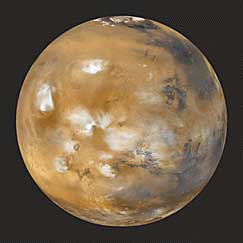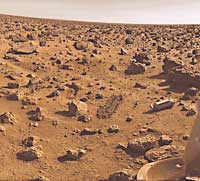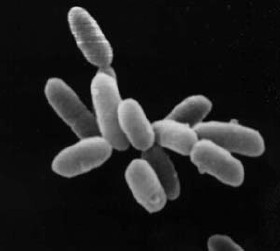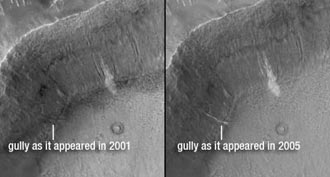Mars: Difference between revisions
(→Past) |
(→Past) |
||
| Line 32: | Line 32: | ||
==Past== | ==Past== | ||
[[Image:Halobacterium.jpg| | [[Image:Halobacterium.jpg|thumb|left|''Halobacterium halbium'' is one of the more likely organisms thought to be able to survive on Mars.]] | ||
''[[Halobacterium]] halobium'' would be one of the leading candidates to survive speculative past Martian conditions. ''H. halobium'' is a facultatitve anaerobe that uses photosynthesis for energy production. It thrives in extremely saline solutions, and can hide in salt deposits when the water freezes or evaporates. ''H. Halobium'' can then re-enter water if it ever reappears, allowing it to survive a daily change in water phases. Being dormant in the salt crystals also serves the purpose of protecting the microbe from the sun's UV radiation. The opaque characteristics of the salt crusts block the shorter wavelengths below 200 nm. The longer UV wavelengths are blocked by rhodopsinlike pigments produced within the microbe. If conditions are unfavorable, ''H. halobium'' can travel by wind gusts to other locations thousands of miles away, which could be better suited to its survival. [http://www.liebertonline.com/doi/abs/10.1089%2F153110701753198927 (12)] | ''[[Halobacterium]] halobium'' would be one of the leading candidates to survive speculative past Martian conditions. ''H. halobium'' is a facultatitve anaerobe that uses photosynthesis for energy production. It thrives in extremely saline solutions, and can hide in salt deposits when the water freezes or evaporates. ''H. Halobium'' can then re-enter water if it ever reappears, allowing it to survive a daily change in water phases. Being dormant in the salt crystals also serves the purpose of protecting the microbe from the sun's UV radiation. The opaque characteristics of the salt crusts block the shorter wavelengths below 200 nm. The longer UV wavelengths are blocked by rhodopsinlike pigments produced within the microbe. If conditions are unfavorable, ''H. halobium'' can travel by wind gusts to other locations thousands of miles away, which could be better suited to its survival. [http://www.liebertonline.com/doi/abs/10.1089%2F153110701753198927 (12)] | ||
Revision as of 04:55, 29 August 2008
Introduction
The possibility of life on Mars, whether extant or prospective, has long been the subject of heated debate in the scientific community. Organisms that can thrive under Mars’ harsh conditions must confront a number of environmental challenges, and possess a variety of unique abilities and characteristics. Restricting our analysis merely to the realm of bacteria, it appears highly unlikely that any terrestrial bacterial organism could (without considerable adaptation) survive on Mars, or that any potential denizens of the current Martian landscape are at all similar to their distant Earthly relatives. That said, Mars is host to a number of environments, or niches, in which members of Archaea or Bacteria could eventually thrive, given the opportunity to accumulate characteristics witnessed in some of Earth’s more exotic members of these families.
In order to assess what these characteristics may be, we must first look at the challenges posed by the environment. One of the primary differences between Earth and Mars is the latter’s lack of a global magnetic field (1). Lost sometime during the planet’s past (2), the magnetic field is unable to sustain the magnetosphere, Earth’s protection against solar wind, cosmic radiation, and asteroid impacts (3). Over time, these have thinned the Martian atmosphere to a fraction of Earth’s, resulting in a host of diverse consequences (4). The effect of a thin atmosphere is multiple-fold; first and foremost, the atmospheric pressure on the planet is far too low to allow for water to exist in the liquid phase. Additionally, Mars’ thin atmosphere is unable to trap heat from the sun, resulting in an extremely wide temperature range. What atmosphere there is, is composed of mostly CO2, and the high salinity and acidity of the soil further complicates the viability of bacterial life. Finally, recent findings reveal a highly oxidizing environment, which in itself is extremely damaging to most terrestrial organisms.
Location
Mars is the fourth planet from the Sun in the Solar System; about 230 million kilometers from the Sun. A Martian year is about 687 days, while a Martian year is about 24.5 hours (5). It's surface area is almost 145 million kilometers. From Earth, this 4.6 billion year old planet appears a bright reddish-range color due to the high iron content in the soil. (6)
The speculative Mars niche is relatively harsh with varying extreme conditions. Many scientists believe Mars to be outside the habitable zone, or distance from the sun. This zone, currently occupied by Earth, allows water to be present on the surface. Because Mars is outside of this zone, the lack of atmosphere causes water to freeze, and UV rays to reach the Martian surface. Mars was a believed to be more habitable planet 3.5 billion years ago, with water covering much of the surface as oceans lakes and rivers. If this theory holds true, there would be a much higher probability of life existing at some point in Martian history. To determine the possibility of life ever existing on Mars, we would need to investigate salt or mineral deposits deep under the surface, which would be protected from damaging cosmic rays. Although evidence exists to support past habitability of water, some scientists believe conditions to have been too salty and acidic for life. (7) Those who believe life exists or extant assume the most habitable environments to be the polar ice caps, subterrain, or crater gullies.
Physical Conditions
The Martian atmosphere is cold, dry, and desolate. The average temperature is -63 deg C. However, depending on the location, the temperature ranges from a low of -143 degrees C at the polar ice caps during the winter to a high of 27 deg C at the lower latitudes during the summer. The atmosphere of Mars has an air pressure that is less than 1% of Earth's atmosphere making it incapable of heat retention at its surface. The low atmospheric pressure is one of the reasons for the cooler temperatures, as well as the wide range between the high and low temperatures. (7)
Liquid water is primary necessity for life to occur on this chemically oxidizing and saline planet. As of yet, there has not been any signs of long-term liquid water on the surface of present day Mars; however there is water in other forms, such as polar ice, permafrost, and small amounts of water vapor in the atmosphere. Liquid water is not likely to be found on the surface due to the low atmospheric pressure but under certain conditions, liquid water can theoretically exist. At the low altitudes of Mars the atmospheric pressure increases in some instances to where water can exist in the liquid phase. Surface temperature also determines the water phase. (8) During the day, the temperature rises to a point where water can subsist, but at night, the temperature drops to below freezing. Lastly, the salinity of the water would be substantial due to the elemental composition of the soil, which contains magnesium, sodium, potassium, and chloride. The salinity of the water would cause the melting point to lower allowing there to be liquid water at lower than normal temperatures. Theoretically, to find water, the most ideal place to look would be in an area of low altitude during the day. (13)
Photolysis of water vapor releases hydrogen radicals and consequently initiate cycles that recycle carbon dioxide from its photolysis product carbon monoxide. These catalytic cycles offer an explanation to the constant 95 per cent carbon dioxide atmosphere. Similar gaseous chemical interactions have shown to be liable for the loss of the ozone in Earth's stratosphere. Current research of the Martian atmosphere has shown similar chemical hydrogen radical reactions in the degradation of the Martian ozone. (9) However, there is hope for a protective elemental flux of oxygen, carbon dioxide, and ozone in the Martian atmosphere. The release of surface particles and dust may eventually offer significant protection against ultraviolet rays as well as hydroxyl radicals. (10) Until this protective atmosphere does form, the ideal living environment would be beneath the soil.
The surface is unlikely to yield a hospitable environment for a number of reasons. First and foremost, water cannot exist in liquid form at the surface, due to the extremely low pressure. While many of Mars' unconventional environments may still allow some type of living organism to exist, the absence of liquid water is an almost universally limiting factor. Furthermore, life on the surface is additionally complicated by the barrage of solar radiation. Radiation damage is particularly harmful to DNA & RNA, and organisms that could survive on the surface would need to have DNA-protective mechanisms in place.
A habitat beneath the soil poses a particularly attractive option for a number of reasons. It has been found ''Escherichia coli'' and ''Deinococcus radiodurans'' viability in simulated Martian conditions (pressure, UV exposure, & temperature) improved dramatically when protected in a microhabitat 5cm beneath the surface (or in liquid water). The conditions at or near the surface, namely, the dessication stress (due to the extremely low pressure), and UV radiation make survival at the surface highly improbable. (11)
Evidence of Life
The arid conditions or the Martian surface is believed to be too cold, dry, and oxidizing for life to survive. If life is to survive, or have survived, organisms would most likely exist in the channel craters, subsurface, or polar ice caps. Conditions on Mars, especially the conditions of the soil and subterrain, can be compared to some of the extreme conditions on Earth. On Earth, we have organisms that are able to adapt to volcanic temperatures, high saline conditions, and acidic conditions. If organisms are able to survive in these extreme conditions on Earth, it is no wonder scientists are probing into possible life on Earth.
Past
Halobacterium halobium would be one of the leading candidates to survive speculative past Martian conditions. H. halobium is a facultatitve anaerobe that uses photosynthesis for energy production. It thrives in extremely saline solutions, and can hide in salt deposits when the water freezes or evaporates. H. Halobium can then re-enter water if it ever reappears, allowing it to survive a daily change in water phases. Being dormant in the salt crystals also serves the purpose of protecting the microbe from the sun's UV radiation. The opaque characteristics of the salt crusts block the shorter wavelengths below 200 nm. The longer UV wavelengths are blocked by rhodopsinlike pigments produced within the microbe. If conditions are unfavorable, H. halobium can travel by wind gusts to other locations thousands of miles away, which could be better suited to its survival. (12)
Present
Recent discoveries of the Martian surface has exposed that methane currently exists in the Martian atmosphere. It has been suggested that methanogens are reasons for the existing methane levels. Methanogens are microorganisms belonging to the Archaea domain and can metabolize hydrogen as a source for energy to incorporate carbon from carbon dioxide into methane. Because life on the arid surface of Mars is unlikely, it must be assumed life to exist below the surface. Possible presence of water under the Martian soil for varying seasonal time periods presents a possibly habitable environment for methanogens. Current research has been able to simulate the Martian dessication and rehydration cycle by adding varying amounts of carbon dioxide, hydrogen, and varying amounts of water. (13) Through this simulant, research found that Methanosarcina barkeri was able to survive dessication over 10 days, while Methanothermobacter wolfeii and Methanobacterium formicium were able to survive for 25 days. (14) Equating the loss rate of methane recently discovered in the Martian atmosphere to the similar climate in the deep ice of Greenland, the presence of methanogens can be extrapolated to be 1 cell per milliliter in a 10 meter thick layer Martian habitat. (15)
Challenges to Life on Mars
Radiation
The absence of a magnetosphere, and the subsequent penetration of solar winds and UV radiation through the atmosphere poses a unique challenge for bacterial life on the Martian surface. Bacteria that seek to thrive in these conditions will need adaptations that help protect their DNA & RNA from the damaging effects of prolonged exposure to this form of radiation, and adaptation already present in some forms of bacterial life on Earth. Some types of bacteria can form spores, entering a period of hibernation, in response to starvation signals. While this adaptation, in itself, would not be particularly useful in a Martian context, the mechanism of sporulation involves the synthesis of SASP proteins, which help to coil the DNA in an extremely compact and dense conformation, considerably improving its resistance to UV damage. Recent studies of Deinococcus radiodurans have shown that aside from inherently-tightly-wound DNA (11), the organism has multiple efficient DNA-repair mechanisms (16). Adaptations like these could allow bacteria to survive, if not thrive, on the surface of the planet. Without them, recent studies have shown that life would be unable to survive above a depth of 7.5 meters below the surface (17).
Liquid Water
The low atmospheric pressure on the Martian surface makes it impossible for water to exist in the liquid phase. For terrestrial life, water is the most essential element of metabolism, and as such, indispensable. Prospective Martian organisms must therefore devise a means of carrying on their metabolic functions without water, or, considerably more likely, populate niches in which liquid water either becomes available at small quantities, or for small periods of time.
Small quantities of liquid water do theoretically exist on Mars; beneath the Martian Polar caps, in micrometer-wide ice veins, water exists at sub-freezing temperatures, but in a liquid-like form that still allows its use as a solvent for the transport of bacterial nutrients and wastes (18). Alternatively, some studies suggest that liquid water may have existed in abundance on the Martian surface in the past, and may currently appear there for extremely brief periods of time – if this were the case, methanogens may hold the key to survival in these conditions (19). Certain members of Methanosarcina and Methanothermobacter were able to survive desiccation under simulated Martian conditions for as long as 25 days (19). Organisms like these would be able to thrive given even brief or sporadic exposures to liquid water.
Oxidative Stress
Recent experiments undertaken by the Phoenix Lander have confirmed the presence of perchlorate, an oxidizing salt, on the Martian surface. Oxidizing conditions can be deleterious for many terrestrial organisms via a process known as oxidative stress, which involves radical damage to cellular components. That said, some organisms have devised methods of reducing this type of damage, via a number of elaborate mechanisms. Spores of B. pumilus SAFR-032 purposely reduce their water content, minimizing the frequency of water reactions that produce these radicals (20). Organisms that have similar characteristics may be well suited to thrive in the highly oxidizing regions of Mars.
High Salinity
The high salt content of Martian soil, likely the vestige of the oceans that covered the planet in its distant past, adds another barrier to thriving bacterial life on the surface of the planet. The oceans, unlike those of Earth, were of extremely high salinity, as recent findings show (21). As the atmosphere withered away under the strain of cosmic radiation and meteorite impacts, the oceans evaporated away, leaving behind the salts that now permeate Martian soil. On Earth, halophiles dominate environments with high salinity, up to 25% in places like the Dead Sea (12). These organisms would have an inherent advantage in thriving under conditions of high salinity, assuming they are also able to contend with the other environmental barriers that exist on the Martian surface.
Temperature Extremes
Yet another challenge to organisms hoping to make their home on Mars is the wide range of temperatures across the planet. A consequence of the thinning atmosphere’s inability to retain solar heat, the varying temperatures make it difficult for microbial organisms to adapt. Some terrestrial microbes have adapted to live at extreme temperatures, but their ability to endure wide ranges of temperatures is limited. The most realistic hope for extremophiles is to select niches where the range is less broad, such as at the Polar Caps, where psychrophiles can adapt to settings not unlike in which they thrive on Earth. Additionally, recent studies have shown that mesophilic bacteria, like certain strains of E. Coli can better handle subzero temperatures when combined with the low-pressure environment that already exists on Mars (11). Rather than acting cumulatively, these effects reduce the efficacy of the stressors individually, improving the chances that some mesophilic bacteria can overcome the temperature barriers to survival on Mars.
Current Research
Research for life on Mars can take two different types of approaches. The first is theoretical experiments, simulating the conditions of different environments on the planet and observing the viability of a specific organism. Conditions such as UV radiation, salinity, dessication can all be simulated
Conclusion
Taken one at a time, the challenges posed to life on Mars are not unlike the kind faced by many terrestrial organisms, many of which are extremophiles that thrive under tumultuous conditions, be it high salinity, or the presence of oxidizing compounds. The biggest problem to the viability of these organisms on Mars is that instead of facing just one of these challenges, they are confronted by several at a time. The potential for bacterial life on Mars then comes down to two distinct possibilities: either the organisms must find a subniche in which it is exposed to only its preferred extremity, and protected from the others, or it must possess numerous adaptations, to be a poly-extremophile in order to confront several of these challenges at once.
References
(1) "MGS/MAGeR" http://mgs-mager.gsfc.nasa.gov/ Accessed Aug 27, 2008.
(2) B.Ouladdiaf, R.Ballou, G.Fillion ,P.Rochette, L.Hood, "How Mars Lost its Magnetism"
(3) Phillips, Tony PhD., "The Solar Winds at Mars" Accessed Aug 27, 2008.
(4) Lundin R., Barabash, S., "Solar Wind-Induced Atmospheric Erosion at Mars: First Results from ASPERA-3 on Mars Express" Science 24 September 2004. Vol. 305. no. 5692, pp. 1933 - 1936. DOI: 10.1126/science.1101860
(6) "Mars: Facts & Figures". NASA. Retrieved on 2008-8-27
(7) Briggs, Helen "Early Mars 'too salty' for life" BBC News Friday, 15 February 2008, 22:27 GMT. Accessed Aug 27, 2008.
(8) David, L., "Reaching for the Red Planet" Aerosp Am. 1996 May;34(5):26-30.
(9) Lefèvre F, Bertaux JL, Clancy RT, Encrenaz T, Fast K, Forget F, Lebonnois S, Montmessin F, Perrier S., "Heterogeneous chemistry in the atmosphere of Mars" Nature. 2008 Aug 21;454(7207):971-5.
(10) Nair H, Allen M, Anbar AD, Yung YL, Clancy RT, "2." Icarus. 1994 Sep;111(1):124-50.
(11) Benjamin Diaz, Dirk Schulze-Makuch. Astrobiology. April 1, 2006, 6(2): 332-347. doi:10.1089/ast.2006.6.332.
(12) Landis, Geoffrey A., "Martian Water: Are There Extant Halobacteria on Mars?" Astrobiology. 2001. Volume 1. p. 161-64.
(13) Kral, Timothy A., Bekkum, Curtis R., McKay, Christopher P., "Growth of Methanogens on a Mars Soil Simulant" Origins of Life and Evolution of Biospheres. Dec 2004. Volume 34.
(14) Kendrick, Michael G., Kral, Timothy A."Survival of Methanogens During Desiccation: Implications for Life on Mars" Astrobiology. August 1, 2006, 6(4): 546-551. doi:10.1089/ast.2006.6.546.
(15) Tung, H. C., Bramall, N. E., Price, P.B., "Microbial origin of excess methane in glacial ice and implications for life on Mars" December 7, 2005, doi: 10.1073/pnas.0507601102.
(16) J. R. Battista, "AGAINST ALL ODDS: The Survival Strategies of Deinococcus radiodurans" Annu. Rev. Microbiol. 1997. 51:203–24
(17) Dartnell, L. R., Desorgher, L., Ward, J. M., Coates, A. J., "Modeling the Surface and Subsurface Martian Radiation Environment: Implications for Astrobiology." Geophysical Research Letters. Vol 34. 2007.
(18) Steven M. Jepsen, John C. Priscu, Robert E. Grimm, Mark A. Bullock. Astrobiology. April 1, 2007, 7(2): 342-354. doi:10.1089/ast.2007.0124.
(19) Michael G. Kendrick, Timothy A. Kral. Astrobiology. August 1, 2006, 6(4): 546-551. doi:10.1089/ast.2006.6.546.
(20) Shariff Osman, Zan Peeters, Myron T. La Duc, Rocco Mancinelli, Pascale Ehrenfreund, and Kasthuri Venkateswaran., "Effect of Shadowing on Survival of Bacteria under Conditions Simulating the Martian Atmosphere and UV Radiation." Appl Environ Microbiol. 2008 February; 74(4): 959–970.
(21) Nicholas J. Tosca, Andrew H. Knoll, Scott M. McLennan., "Water Activity and the Challenge for Life on Early Mars." Science 30 May 2008: Vol. 320. no. 5880, pp. 1204 - 1207 DOI: 10.1126/science.1155432
(22)
Edited by Hank Hoang, Herman Davidovics, Grigoriy Shekhtman, students of Rachel Larsen







